Penfolds Grange Shiraz: Strategic Analysis & Growth Strategies
VerifiedAdded on 2023/06/11
|16
|3800
|66
Report
AI Summary
This report provides a strategic analysis of Penfolds Grange Shiraz within the Australian wine industry, examining its macro and micro environments through PESTLE analysis and competitive forces. It identifies Penfolds' competitive advantages and explores the generic strategies employed, including cost leadership, differentiation, and focus. The report further investigates the company's growth strategies, particularly Ansoff's Product-Market Expansion grid, and concludes with strategic recommendations for functional and business-level improvements. This comprehensive analysis offers insights into Penfolds' market position and future growth prospects, highlighting the dynamics of the Australian wine sector.
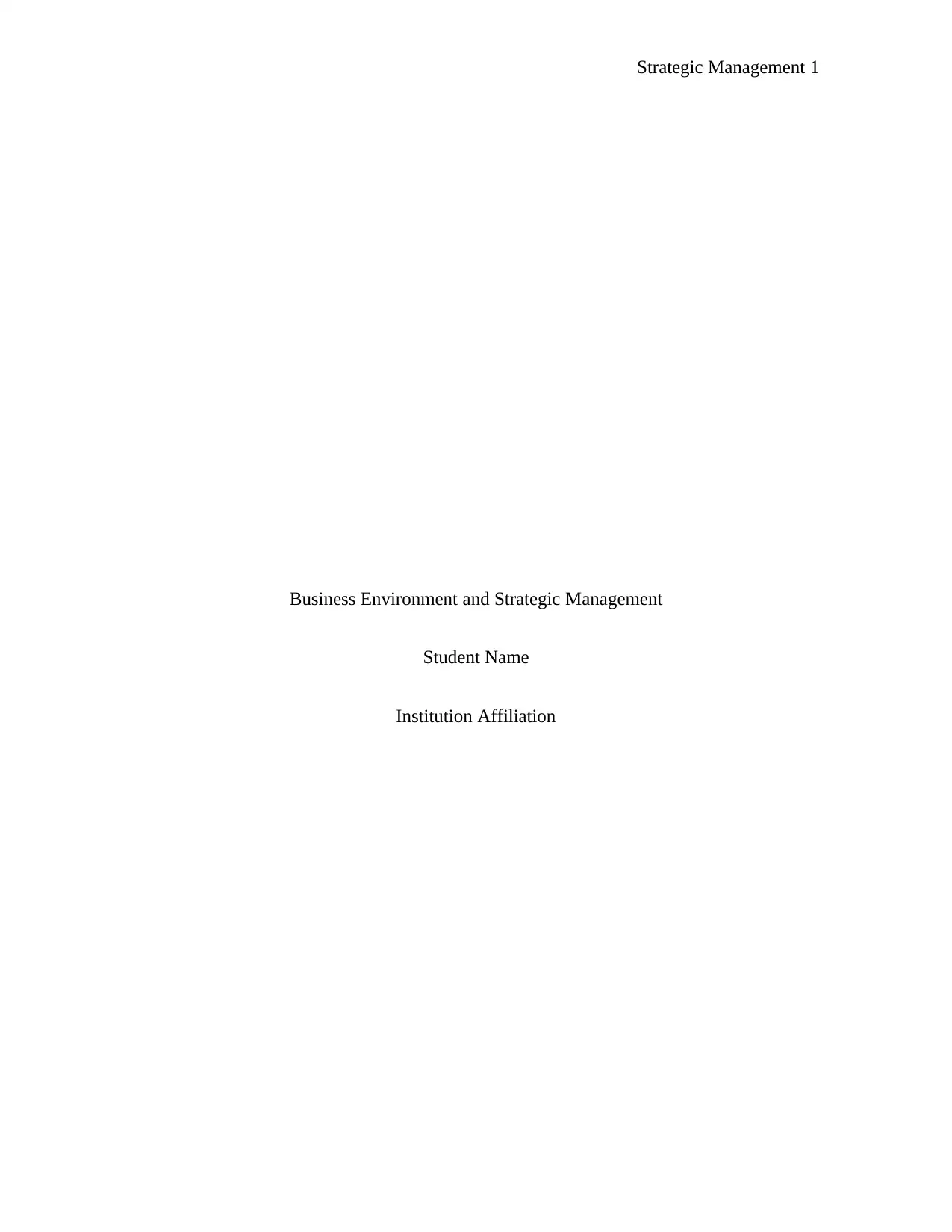
Strategic Management 1
Business Environment and Strategic Management
Student Name
Institution Affiliation
Business Environment and Strategic Management
Student Name
Institution Affiliation
Paraphrase This Document
Need a fresh take? Get an instant paraphrase of this document with our AI Paraphraser
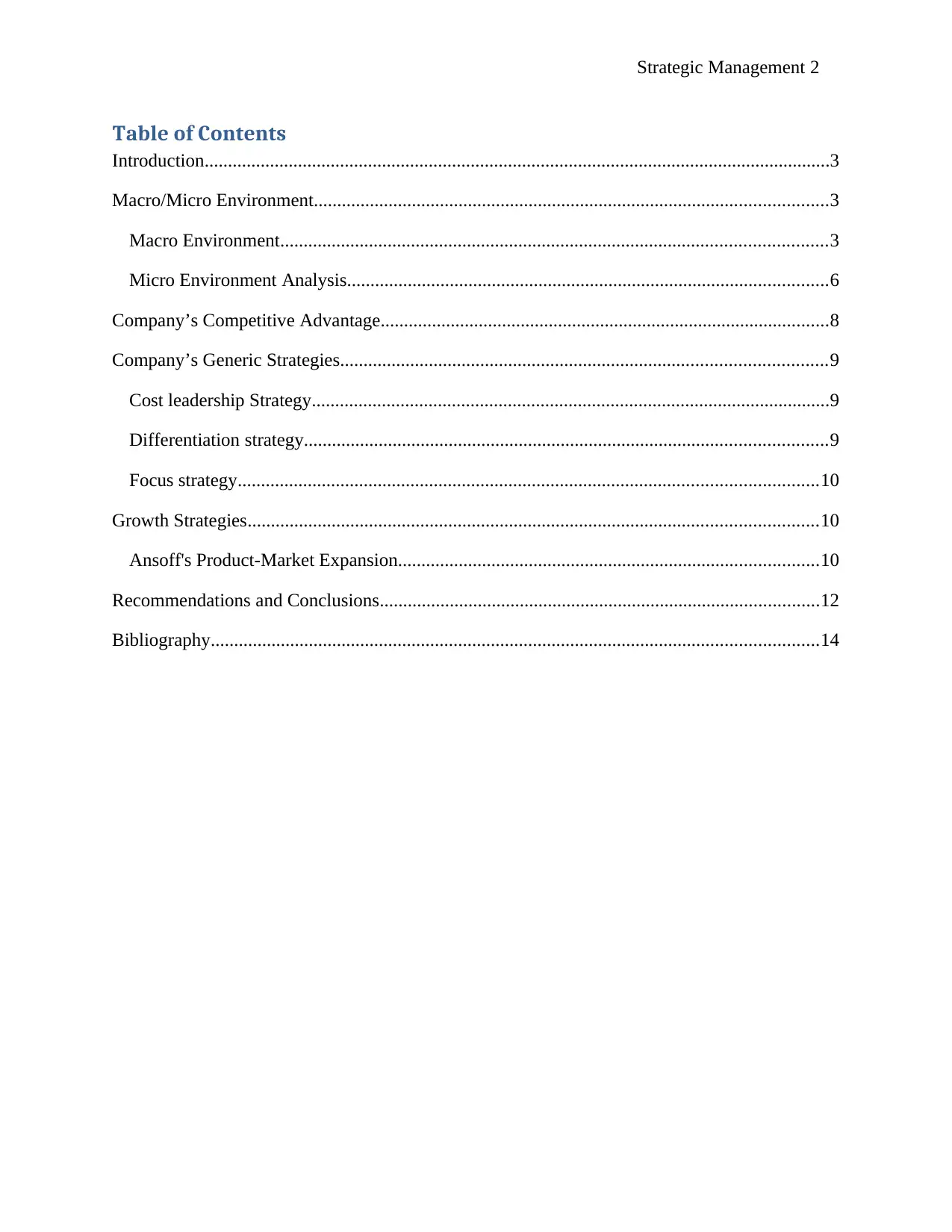
Strategic Management 2
Table of Contents
Introduction......................................................................................................................................3
Macro/Micro Environment..............................................................................................................3
Macro Environment.....................................................................................................................3
Micro Environment Analysis.......................................................................................................6
Company’s Competitive Advantage................................................................................................8
Company’s Generic Strategies........................................................................................................9
Cost leadership Strategy...............................................................................................................9
Differentiation strategy................................................................................................................9
Focus strategy............................................................................................................................10
Growth Strategies..........................................................................................................................10
Ansoff's Product-Market Expansion..........................................................................................10
Recommendations and Conclusions..............................................................................................12
Bibliography..................................................................................................................................14
Table of Contents
Introduction......................................................................................................................................3
Macro/Micro Environment..............................................................................................................3
Macro Environment.....................................................................................................................3
Micro Environment Analysis.......................................................................................................6
Company’s Competitive Advantage................................................................................................8
Company’s Generic Strategies........................................................................................................9
Cost leadership Strategy...............................................................................................................9
Differentiation strategy................................................................................................................9
Focus strategy............................................................................................................................10
Growth Strategies..........................................................................................................................10
Ansoff's Product-Market Expansion..........................................................................................10
Recommendations and Conclusions..............................................................................................12
Bibliography..................................................................................................................................14
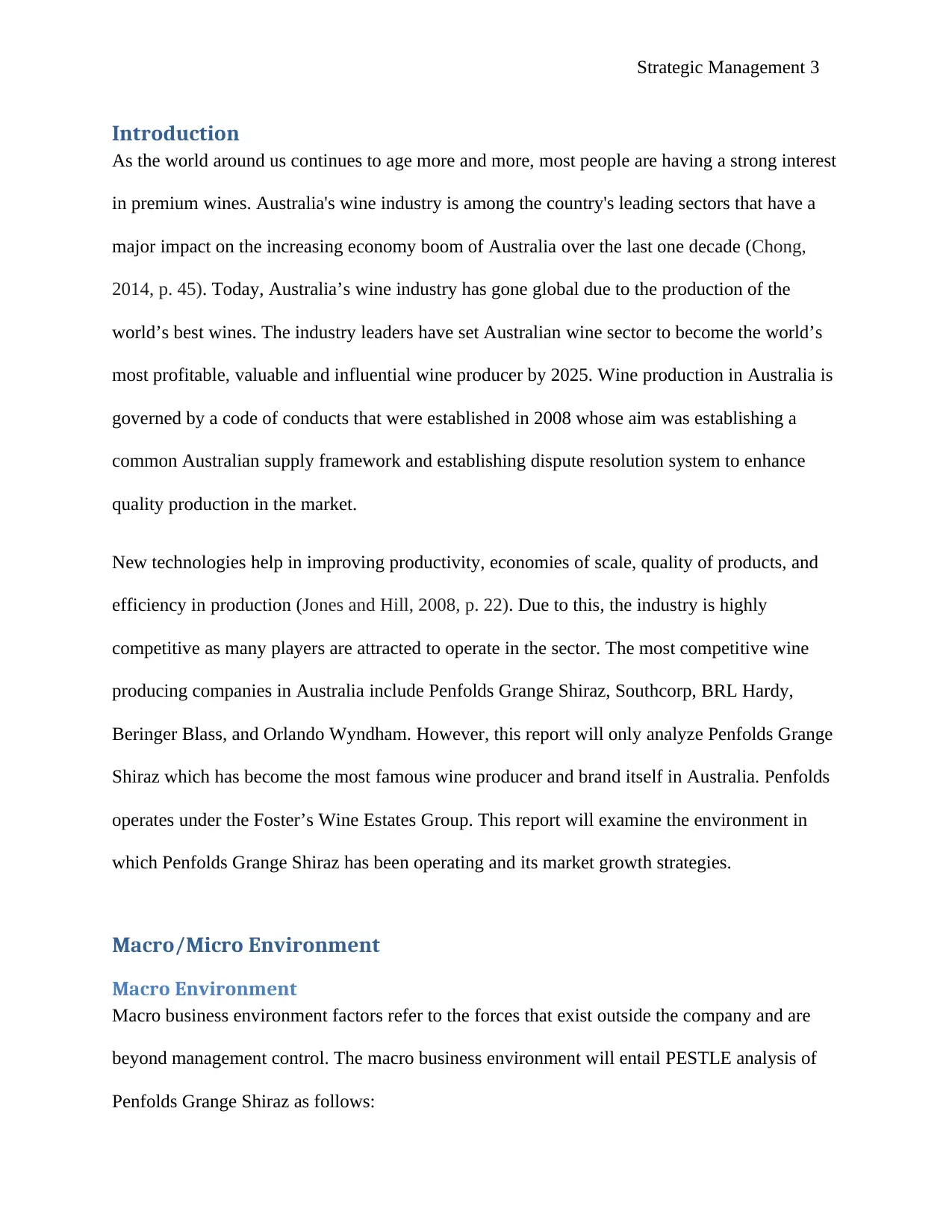
Strategic Management 3
Introduction
As the world around us continues to age more and more, most people are having a strong interest
in premium wines. Australia's wine industry is among the country's leading sectors that have a
major impact on the increasing economy boom of Australia over the last one decade (Chong,
2014, p. 45). Today, Australia’s wine industry has gone global due to the production of the
world’s best wines. The industry leaders have set Australian wine sector to become the world’s
most profitable, valuable and influential wine producer by 2025. Wine production in Australia is
governed by a code of conducts that were established in 2008 whose aim was establishing a
common Australian supply framework and establishing dispute resolution system to enhance
quality production in the market.
New technologies help in improving productivity, economies of scale, quality of products, and
efficiency in production (Jones and Hill, 2008, p. 22). Due to this, the industry is highly
competitive as many players are attracted to operate in the sector. The most competitive wine
producing companies in Australia include Penfolds Grange Shiraz, Southcorp, BRL Hardy,
Beringer Blass, and Orlando Wyndham. However, this report will only analyze Penfolds Grange
Shiraz which has become the most famous wine producer and brand itself in Australia. Penfolds
operates under the Foster’s Wine Estates Group. This report will examine the environment in
which Penfolds Grange Shiraz has been operating and its market growth strategies.
Macro/Micro Environment
Macro Environment
Macro business environment factors refer to the forces that exist outside the company and are
beyond management control. The macro business environment will entail PESTLE analysis of
Penfolds Grange Shiraz as follows:
Introduction
As the world around us continues to age more and more, most people are having a strong interest
in premium wines. Australia's wine industry is among the country's leading sectors that have a
major impact on the increasing economy boom of Australia over the last one decade (Chong,
2014, p. 45). Today, Australia’s wine industry has gone global due to the production of the
world’s best wines. The industry leaders have set Australian wine sector to become the world’s
most profitable, valuable and influential wine producer by 2025. Wine production in Australia is
governed by a code of conducts that were established in 2008 whose aim was establishing a
common Australian supply framework and establishing dispute resolution system to enhance
quality production in the market.
New technologies help in improving productivity, economies of scale, quality of products, and
efficiency in production (Jones and Hill, 2008, p. 22). Due to this, the industry is highly
competitive as many players are attracted to operate in the sector. The most competitive wine
producing companies in Australia include Penfolds Grange Shiraz, Southcorp, BRL Hardy,
Beringer Blass, and Orlando Wyndham. However, this report will only analyze Penfolds Grange
Shiraz which has become the most famous wine producer and brand itself in Australia. Penfolds
operates under the Foster’s Wine Estates Group. This report will examine the environment in
which Penfolds Grange Shiraz has been operating and its market growth strategies.
Macro/Micro Environment
Macro Environment
Macro business environment factors refer to the forces that exist outside the company and are
beyond management control. The macro business environment will entail PESTLE analysis of
Penfolds Grange Shiraz as follows:
⊘ This is a preview!⊘
Do you want full access?
Subscribe today to unlock all pages.

Trusted by 1+ million students worldwide
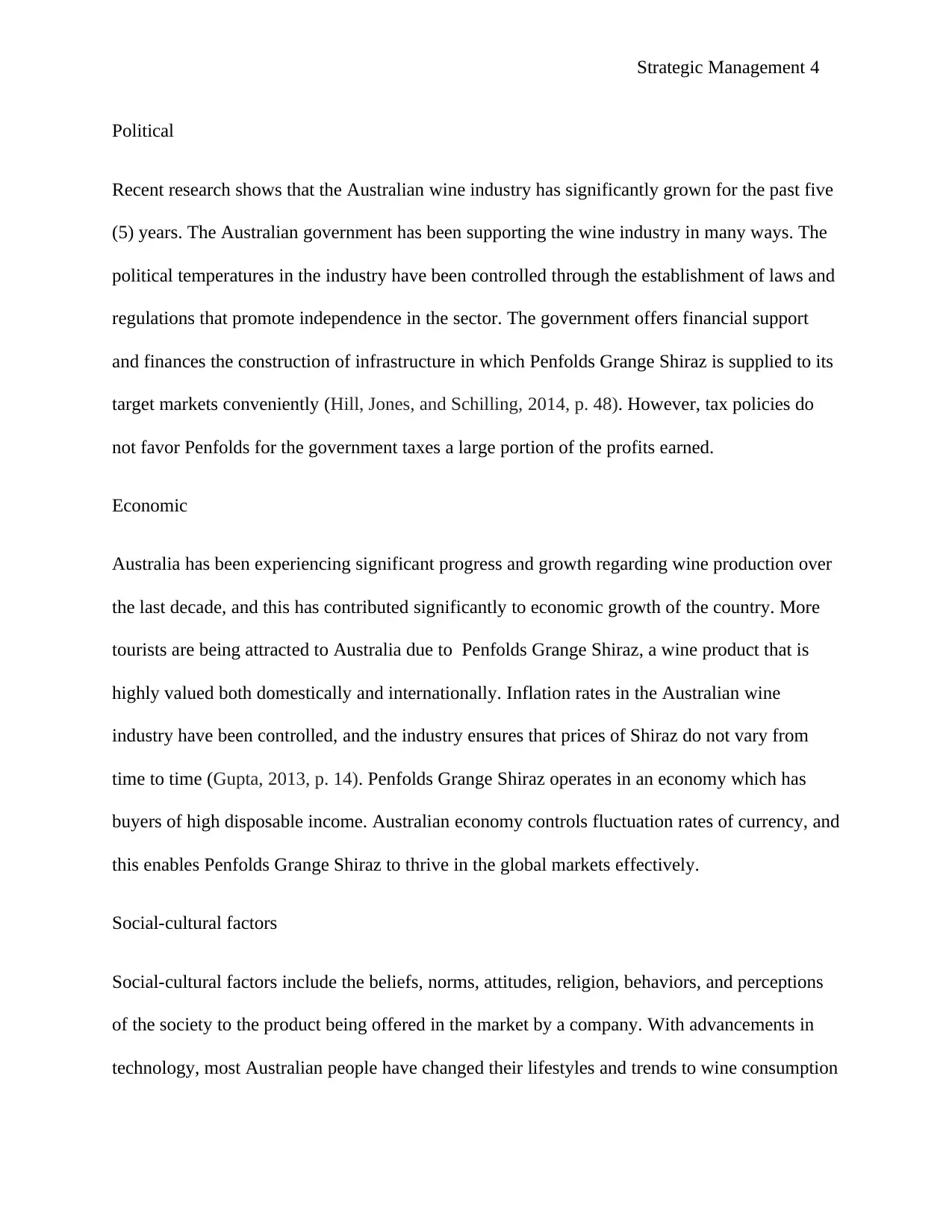
Strategic Management 4
Political
Recent research shows that the Australian wine industry has significantly grown for the past five
(5) years. The Australian government has been supporting the wine industry in many ways. The
political temperatures in the industry have been controlled through the establishment of laws and
regulations that promote independence in the sector. The government offers financial support
and finances the construction of infrastructure in which Penfolds Grange Shiraz is supplied to its
target markets conveniently (Hill, Jones, and Schilling, 2014, p. 48). However, tax policies do
not favor Penfolds for the government taxes a large portion of the profits earned.
Economic
Australia has been experiencing significant progress and growth regarding wine production over
the last decade, and this has contributed significantly to economic growth of the country. More
tourists are being attracted to Australia due to Penfolds Grange Shiraz, a wine product that is
highly valued both domestically and internationally. Inflation rates in the Australian wine
industry have been controlled, and the industry ensures that prices of Shiraz do not vary from
time to time (Gupta, 2013, p. 14). Penfolds Grange Shiraz operates in an economy which has
buyers of high disposable income. Australian economy controls fluctuation rates of currency, and
this enables Penfolds Grange Shiraz to thrive in the global markets effectively.
Social-cultural factors
Social-cultural factors include the beliefs, norms, attitudes, religion, behaviors, and perceptions
of the society to the product being offered in the market by a company. With advancements in
technology, most Australian people have changed their lifestyles and trends to wine consumption
Political
Recent research shows that the Australian wine industry has significantly grown for the past five
(5) years. The Australian government has been supporting the wine industry in many ways. The
political temperatures in the industry have been controlled through the establishment of laws and
regulations that promote independence in the sector. The government offers financial support
and finances the construction of infrastructure in which Penfolds Grange Shiraz is supplied to its
target markets conveniently (Hill, Jones, and Schilling, 2014, p. 48). However, tax policies do
not favor Penfolds for the government taxes a large portion of the profits earned.
Economic
Australia has been experiencing significant progress and growth regarding wine production over
the last decade, and this has contributed significantly to economic growth of the country. More
tourists are being attracted to Australia due to Penfolds Grange Shiraz, a wine product that is
highly valued both domestically and internationally. Inflation rates in the Australian wine
industry have been controlled, and the industry ensures that prices of Shiraz do not vary from
time to time (Gupta, 2013, p. 14). Penfolds Grange Shiraz operates in an economy which has
buyers of high disposable income. Australian economy controls fluctuation rates of currency, and
this enables Penfolds Grange Shiraz to thrive in the global markets effectively.
Social-cultural factors
Social-cultural factors include the beliefs, norms, attitudes, religion, behaviors, and perceptions
of the society to the product being offered in the market by a company. With advancements in
technology, most Australian people have changed their lifestyles and trends to wine consumption
Paraphrase This Document
Need a fresh take? Get an instant paraphrase of this document with our AI Paraphraser

Strategic Management 5
(David, 2011, p. 16). Most people are valuing and consuming wine products produced by
Penfolds Grange Shiraz. On the other side, there have been no significant changes in the societal
beliefs, norms, and attitudes towards wine production. Most Australian citizens are Muslims, and
this brings the aspect of religion-related factors to Penfolds Grange Shiraz's wine operations in
the country.
Technological
Technology greatly affects the wine industry, and this has led to the creation and innovation of
more demanded and valued wine brands to Australia. Penfolds Grange Shiraz operates in the
technologically competitive wine industry and faces stiff competition from Southcorp, BRL
Hardy, Beringer Blass, and Orlando Wyndham who are technologically competitive wine
producers in the market (Smith and Marsh, 2007, p. 225). However, the management of
Southcorp, BRL Hardy, Beringer Blass, and Orlando Wyndham has invested more in wine
production technologies, and this leads to the innovation of new products.
Legal
Wine production in Australia is governed by a code of conducts that were established in 2008
whose aim was establishing a common Australian supply framework and establishing dispute
resolution system to enhance quality production in the market. Penfolds Grange Shiraz operates
following this law (Hill and Schilling, 2015, p. 120). Also, the company own patent rights on its
products and has also established health and safety regulations that seek to protect employees’
rights and patent infringements.
Environmental
(David, 2011, p. 16). Most people are valuing and consuming wine products produced by
Penfolds Grange Shiraz. On the other side, there have been no significant changes in the societal
beliefs, norms, and attitudes towards wine production. Most Australian citizens are Muslims, and
this brings the aspect of religion-related factors to Penfolds Grange Shiraz's wine operations in
the country.
Technological
Technology greatly affects the wine industry, and this has led to the creation and innovation of
more demanded and valued wine brands to Australia. Penfolds Grange Shiraz operates in the
technologically competitive wine industry and faces stiff competition from Southcorp, BRL
Hardy, Beringer Blass, and Orlando Wyndham who are technologically competitive wine
producers in the market (Smith and Marsh, 2007, p. 225). However, the management of
Southcorp, BRL Hardy, Beringer Blass, and Orlando Wyndham has invested more in wine
production technologies, and this leads to the innovation of new products.
Legal
Wine production in Australia is governed by a code of conducts that were established in 2008
whose aim was establishing a common Australian supply framework and establishing dispute
resolution system to enhance quality production in the market. Penfolds Grange Shiraz operates
following this law (Hill and Schilling, 2015, p. 120). Also, the company own patent rights on its
products and has also established health and safety regulations that seek to protect employees’
rights and patent infringements.
Environmental
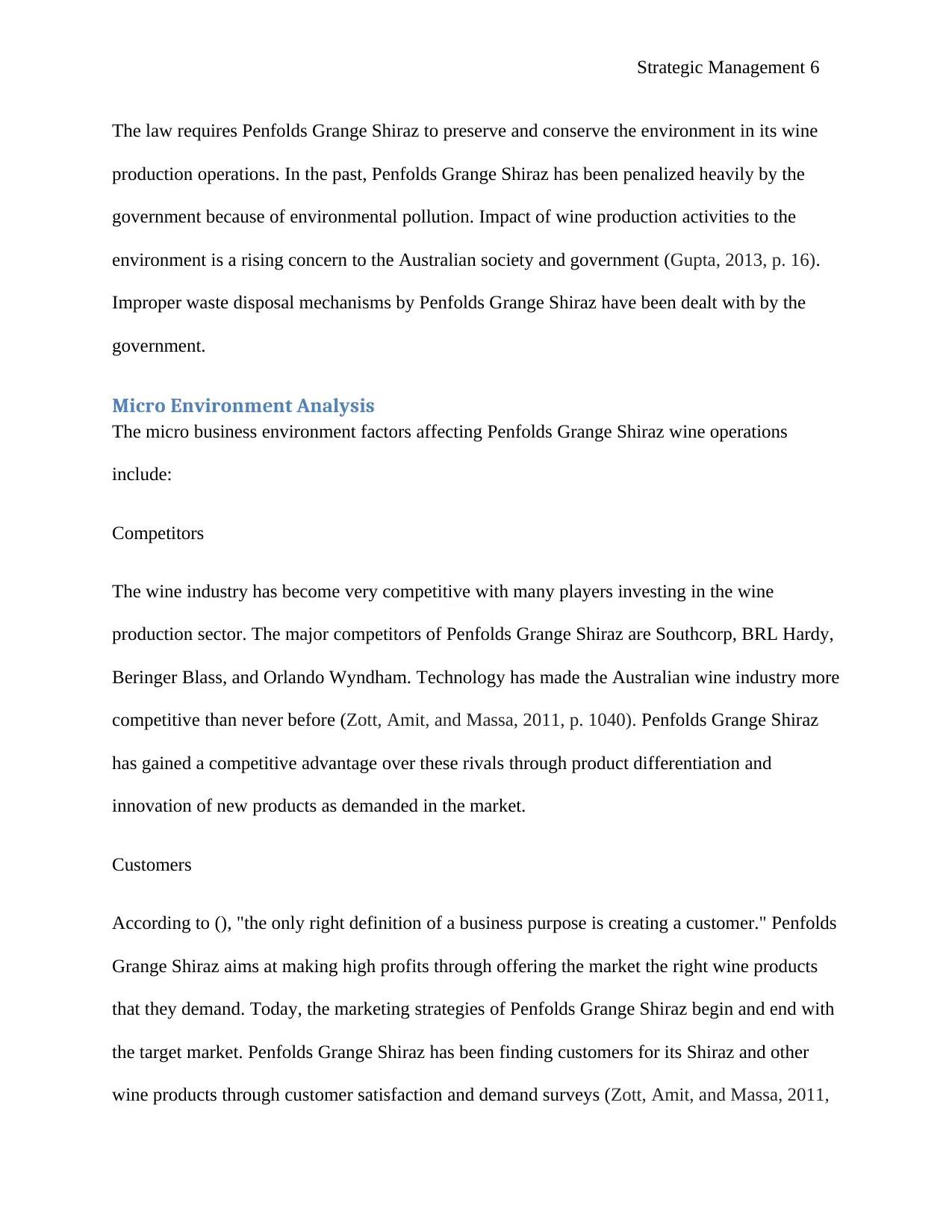
Strategic Management 6
The law requires Penfolds Grange Shiraz to preserve and conserve the environment in its wine
production operations. In the past, Penfolds Grange Shiraz has been penalized heavily by the
government because of environmental pollution. Impact of wine production activities to the
environment is a rising concern to the Australian society and government (Gupta, 2013, p. 16).
Improper waste disposal mechanisms by Penfolds Grange Shiraz have been dealt with by the
government.
Micro Environment Analysis
The micro business environment factors affecting Penfolds Grange Shiraz wine operations
include:
Competitors
The wine industry has become very competitive with many players investing in the wine
production sector. The major competitors of Penfolds Grange Shiraz are Southcorp, BRL Hardy,
Beringer Blass, and Orlando Wyndham. Technology has made the Australian wine industry more
competitive than never before (Zott, Amit, and Massa, 2011, p. 1040). Penfolds Grange Shiraz
has gained a competitive advantage over these rivals through product differentiation and
innovation of new products as demanded in the market.
Customers
According to (), "the only right definition of a business purpose is creating a customer." Penfolds
Grange Shiraz aims at making high profits through offering the market the right wine products
that they demand. Today, the marketing strategies of Penfolds Grange Shiraz begin and end with
the target market. Penfolds Grange Shiraz has been finding customers for its Shiraz and other
wine products through customer satisfaction and demand surveys (Zott, Amit, and Massa, 2011,
The law requires Penfolds Grange Shiraz to preserve and conserve the environment in its wine
production operations. In the past, Penfolds Grange Shiraz has been penalized heavily by the
government because of environmental pollution. Impact of wine production activities to the
environment is a rising concern to the Australian society and government (Gupta, 2013, p. 16).
Improper waste disposal mechanisms by Penfolds Grange Shiraz have been dealt with by the
government.
Micro Environment Analysis
The micro business environment factors affecting Penfolds Grange Shiraz wine operations
include:
Competitors
The wine industry has become very competitive with many players investing in the wine
production sector. The major competitors of Penfolds Grange Shiraz are Southcorp, BRL Hardy,
Beringer Blass, and Orlando Wyndham. Technology has made the Australian wine industry more
competitive than never before (Zott, Amit, and Massa, 2011, p. 1040). Penfolds Grange Shiraz
has gained a competitive advantage over these rivals through product differentiation and
innovation of new products as demanded in the market.
Customers
According to (), "the only right definition of a business purpose is creating a customer." Penfolds
Grange Shiraz aims at making high profits through offering the market the right wine products
that they demand. Today, the marketing strategies of Penfolds Grange Shiraz begin and end with
the target market. Penfolds Grange Shiraz has been finding customers for its Shiraz and other
wine products through customer satisfaction and demand surveys (Zott, Amit, and Massa, 2011,
⊘ This is a preview!⊘
Do you want full access?
Subscribe today to unlock all pages.

Trusted by 1+ million students worldwide
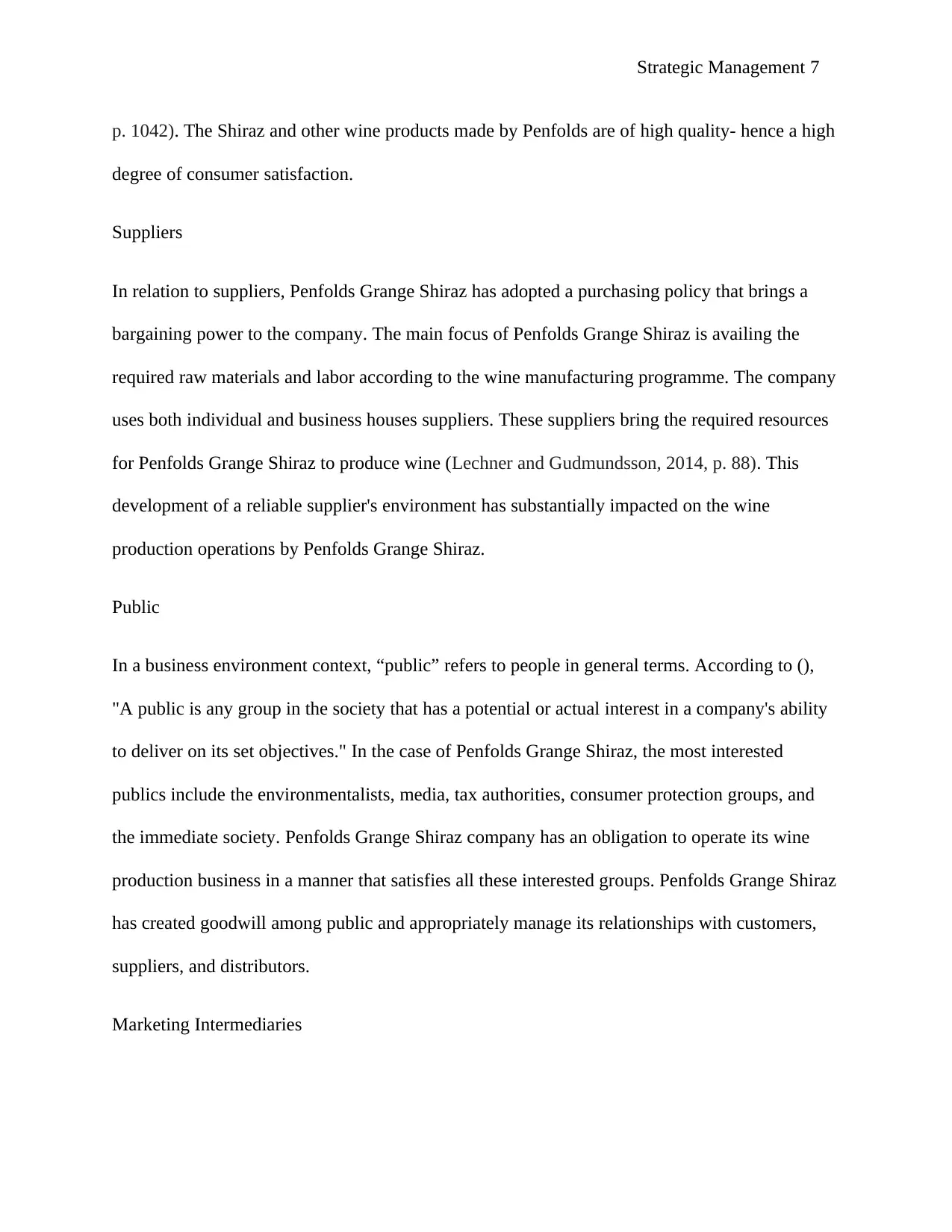
Strategic Management 7
p. 1042). The Shiraz and other wine products made by Penfolds are of high quality- hence a high
degree of consumer satisfaction.
Suppliers
In relation to suppliers, Penfolds Grange Shiraz has adopted a purchasing policy that brings a
bargaining power to the company. The main focus of Penfolds Grange Shiraz is availing the
required raw materials and labor according to the wine manufacturing programme. The company
uses both individual and business houses suppliers. These suppliers bring the required resources
for Penfolds Grange Shiraz to produce wine (Lechner and Gudmundsson, 2014, p. 88). This
development of a reliable supplier's environment has substantially impacted on the wine
production operations by Penfolds Grange Shiraz.
Public
In a business environment context, “public” refers to people in general terms. According to (),
"A public is any group in the society that has a potential or actual interest in a company's ability
to deliver on its set objectives." In the case of Penfolds Grange Shiraz, the most interested
publics include the environmentalists, media, tax authorities, consumer protection groups, and
the immediate society. Penfolds Grange Shiraz company has an obligation to operate its wine
production business in a manner that satisfies all these interested groups. Penfolds Grange Shiraz
has created goodwill among public and appropriately manage its relationships with customers,
suppliers, and distributors.
Marketing Intermediaries
p. 1042). The Shiraz and other wine products made by Penfolds are of high quality- hence a high
degree of consumer satisfaction.
Suppliers
In relation to suppliers, Penfolds Grange Shiraz has adopted a purchasing policy that brings a
bargaining power to the company. The main focus of Penfolds Grange Shiraz is availing the
required raw materials and labor according to the wine manufacturing programme. The company
uses both individual and business houses suppliers. These suppliers bring the required resources
for Penfolds Grange Shiraz to produce wine (Lechner and Gudmundsson, 2014, p. 88). This
development of a reliable supplier's environment has substantially impacted on the wine
production operations by Penfolds Grange Shiraz.
Public
In a business environment context, “public” refers to people in general terms. According to (),
"A public is any group in the society that has a potential or actual interest in a company's ability
to deliver on its set objectives." In the case of Penfolds Grange Shiraz, the most interested
publics include the environmentalists, media, tax authorities, consumer protection groups, and
the immediate society. Penfolds Grange Shiraz company has an obligation to operate its wine
production business in a manner that satisfies all these interested groups. Penfolds Grange Shiraz
has created goodwill among public and appropriately manage its relationships with customers,
suppliers, and distributors.
Marketing Intermediaries
Paraphrase This Document
Need a fresh take? Get an instant paraphrase of this document with our AI Paraphraser
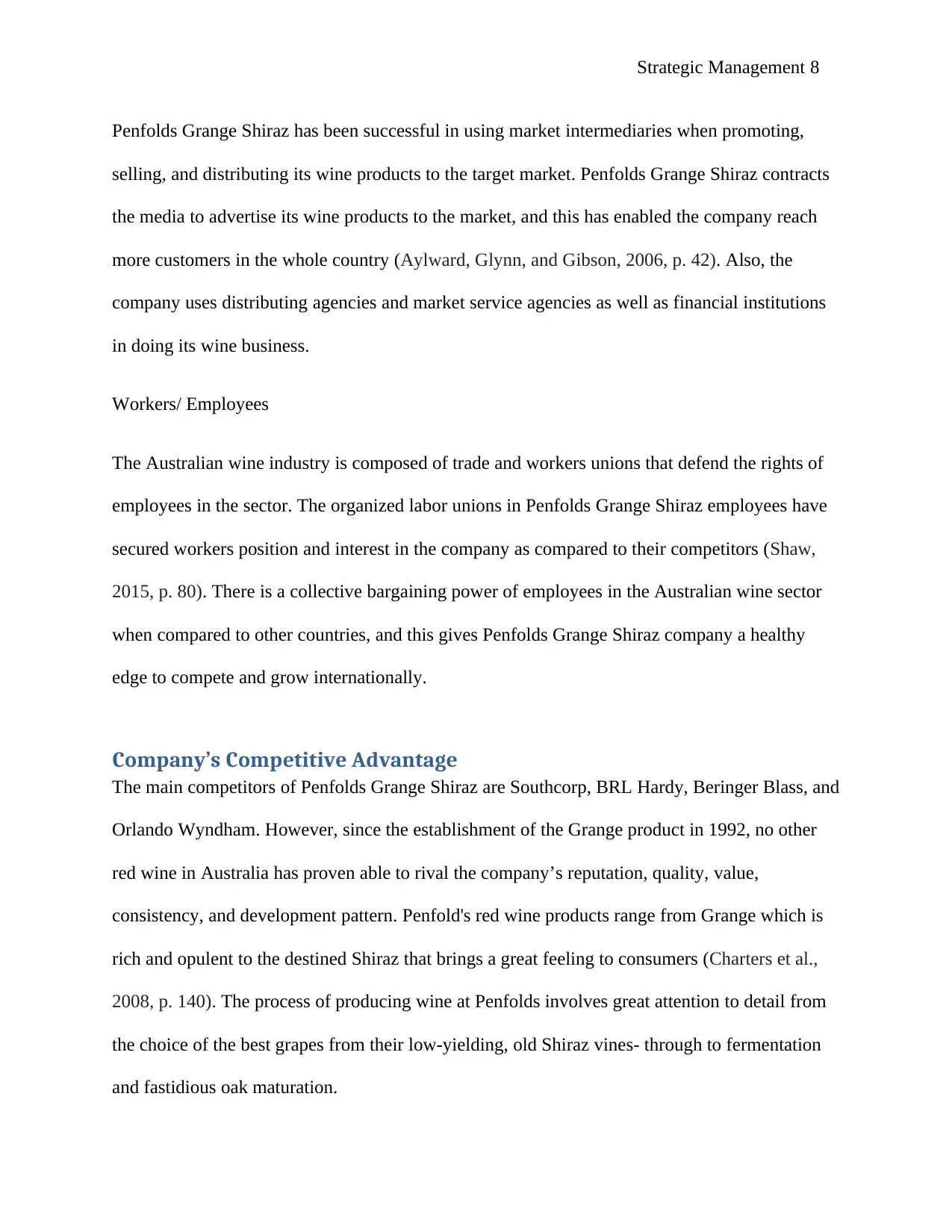
Strategic Management 8
Penfolds Grange Shiraz has been successful in using market intermediaries when promoting,
selling, and distributing its wine products to the target market. Penfolds Grange Shiraz contracts
the media to advertise its wine products to the market, and this has enabled the company reach
more customers in the whole country (Aylward, Glynn, and Gibson, 2006, p. 42). Also, the
company uses distributing agencies and market service agencies as well as financial institutions
in doing its wine business.
Workers/ Employees
The Australian wine industry is composed of trade and workers unions that defend the rights of
employees in the sector. The organized labor unions in Penfolds Grange Shiraz employees have
secured workers position and interest in the company as compared to their competitors (Shaw,
2015, p. 80). There is a collective bargaining power of employees in the Australian wine sector
when compared to other countries, and this gives Penfolds Grange Shiraz company a healthy
edge to compete and grow internationally.
Company’s Competitive Advantage
The main competitors of Penfolds Grange Shiraz are Southcorp, BRL Hardy, Beringer Blass, and
Orlando Wyndham. However, since the establishment of the Grange product in 1992, no other
red wine in Australia has proven able to rival the company’s reputation, quality, value,
consistency, and development pattern. Penfold's red wine products range from Grange which is
rich and opulent to the destined Shiraz that brings a great feeling to consumers (Charters et al.,
2008, p. 140). The process of producing wine at Penfolds involves great attention to detail from
the choice of the best grapes from their low-yielding, old Shiraz vines- through to fermentation
and fastidious oak maturation.
Penfolds Grange Shiraz has been successful in using market intermediaries when promoting,
selling, and distributing its wine products to the target market. Penfolds Grange Shiraz contracts
the media to advertise its wine products to the market, and this has enabled the company reach
more customers in the whole country (Aylward, Glynn, and Gibson, 2006, p. 42). Also, the
company uses distributing agencies and market service agencies as well as financial institutions
in doing its wine business.
Workers/ Employees
The Australian wine industry is composed of trade and workers unions that defend the rights of
employees in the sector. The organized labor unions in Penfolds Grange Shiraz employees have
secured workers position and interest in the company as compared to their competitors (Shaw,
2015, p. 80). There is a collective bargaining power of employees in the Australian wine sector
when compared to other countries, and this gives Penfolds Grange Shiraz company a healthy
edge to compete and grow internationally.
Company’s Competitive Advantage
The main competitors of Penfolds Grange Shiraz are Southcorp, BRL Hardy, Beringer Blass, and
Orlando Wyndham. However, since the establishment of the Grange product in 1992, no other
red wine in Australia has proven able to rival the company’s reputation, quality, value,
consistency, and development pattern. Penfold's red wine products range from Grange which is
rich and opulent to the destined Shiraz that brings a great feeling to consumers (Charters et al.,
2008, p. 140). The process of producing wine at Penfolds involves great attention to detail from
the choice of the best grapes from their low-yielding, old Shiraz vines- through to fermentation
and fastidious oak maturation.
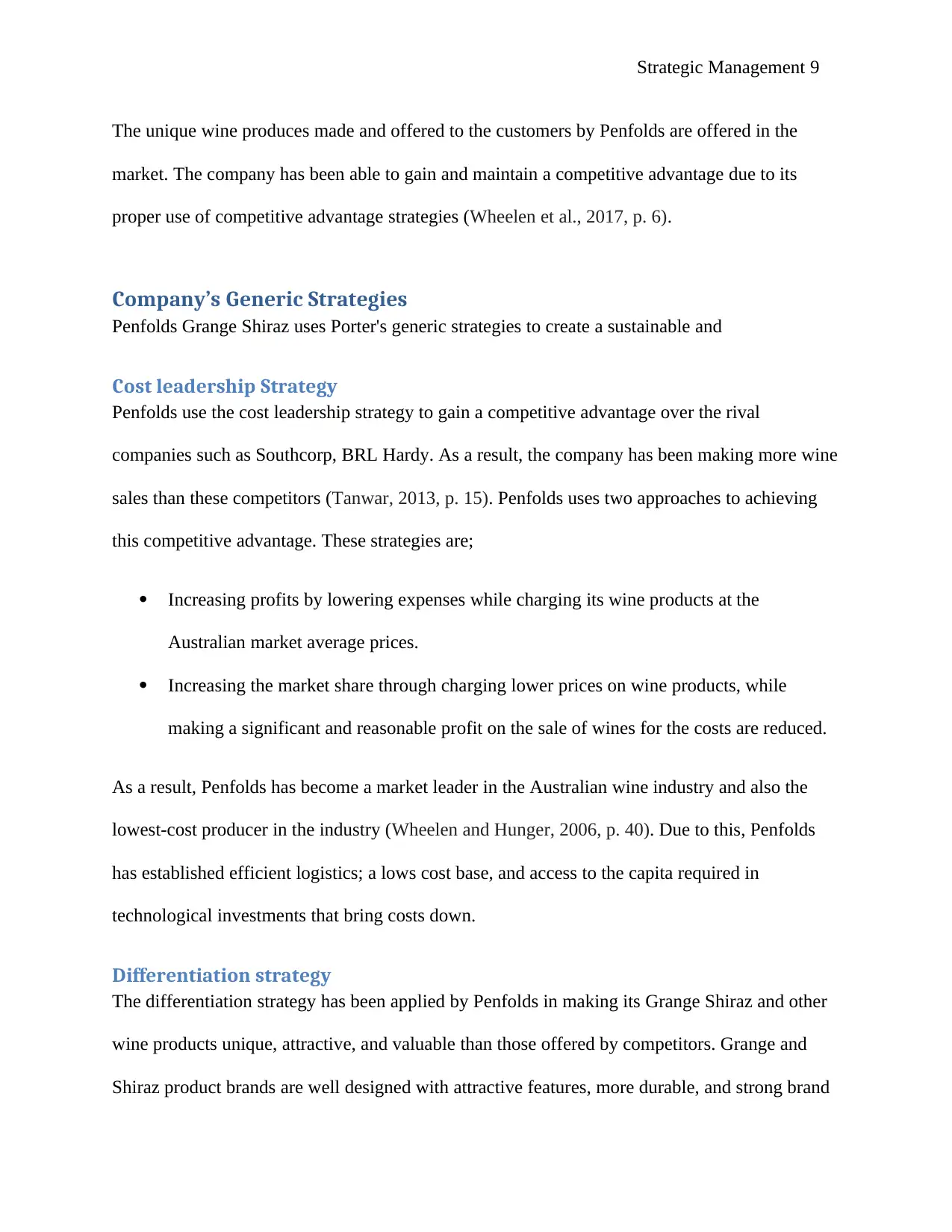
Strategic Management 9
The unique wine produces made and offered to the customers by Penfolds are offered in the
market. The company has been able to gain and maintain a competitive advantage due to its
proper use of competitive advantage strategies (Wheelen et al., 2017, p. 6).
Company’s Generic Strategies
Penfolds Grange Shiraz uses Porter's generic strategies to create a sustainable and
Cost leadership Strategy
Penfolds use the cost leadership strategy to gain a competitive advantage over the rival
companies such as Southcorp, BRL Hardy. As a result, the company has been making more wine
sales than these competitors (Tanwar, 2013, p. 15). Penfolds uses two approaches to achieving
this competitive advantage. These strategies are;
Increasing profits by lowering expenses while charging its wine products at the
Australian market average prices.
Increasing the market share through charging lower prices on wine products, while
making a significant and reasonable profit on the sale of wines for the costs are reduced.
As a result, Penfolds has become a market leader in the Australian wine industry and also the
lowest-cost producer in the industry (Wheelen and Hunger, 2006, p. 40). Due to this, Penfolds
has established efficient logistics; a lows cost base, and access to the capita required in
technological investments that bring costs down.
Differentiation strategy
The differentiation strategy has been applied by Penfolds in making its Grange Shiraz and other
wine products unique, attractive, and valuable than those offered by competitors. Grange and
Shiraz product brands are well designed with attractive features, more durable, and strong brand
The unique wine produces made and offered to the customers by Penfolds are offered in the
market. The company has been able to gain and maintain a competitive advantage due to its
proper use of competitive advantage strategies (Wheelen et al., 2017, p. 6).
Company’s Generic Strategies
Penfolds Grange Shiraz uses Porter's generic strategies to create a sustainable and
Cost leadership Strategy
Penfolds use the cost leadership strategy to gain a competitive advantage over the rival
companies such as Southcorp, BRL Hardy. As a result, the company has been making more wine
sales than these competitors (Tanwar, 2013, p. 15). Penfolds uses two approaches to achieving
this competitive advantage. These strategies are;
Increasing profits by lowering expenses while charging its wine products at the
Australian market average prices.
Increasing the market share through charging lower prices on wine products, while
making a significant and reasonable profit on the sale of wines for the costs are reduced.
As a result, Penfolds has become a market leader in the Australian wine industry and also the
lowest-cost producer in the industry (Wheelen and Hunger, 2006, p. 40). Due to this, Penfolds
has established efficient logistics; a lows cost base, and access to the capita required in
technological investments that bring costs down.
Differentiation strategy
The differentiation strategy has been applied by Penfolds in making its Grange Shiraz and other
wine products unique, attractive, and valuable than those offered by competitors. Grange and
Shiraz product brands are well designed with attractive features, more durable, and strong brand
⊘ This is a preview!⊘
Do you want full access?
Subscribe today to unlock all pages.

Trusted by 1+ million students worldwide
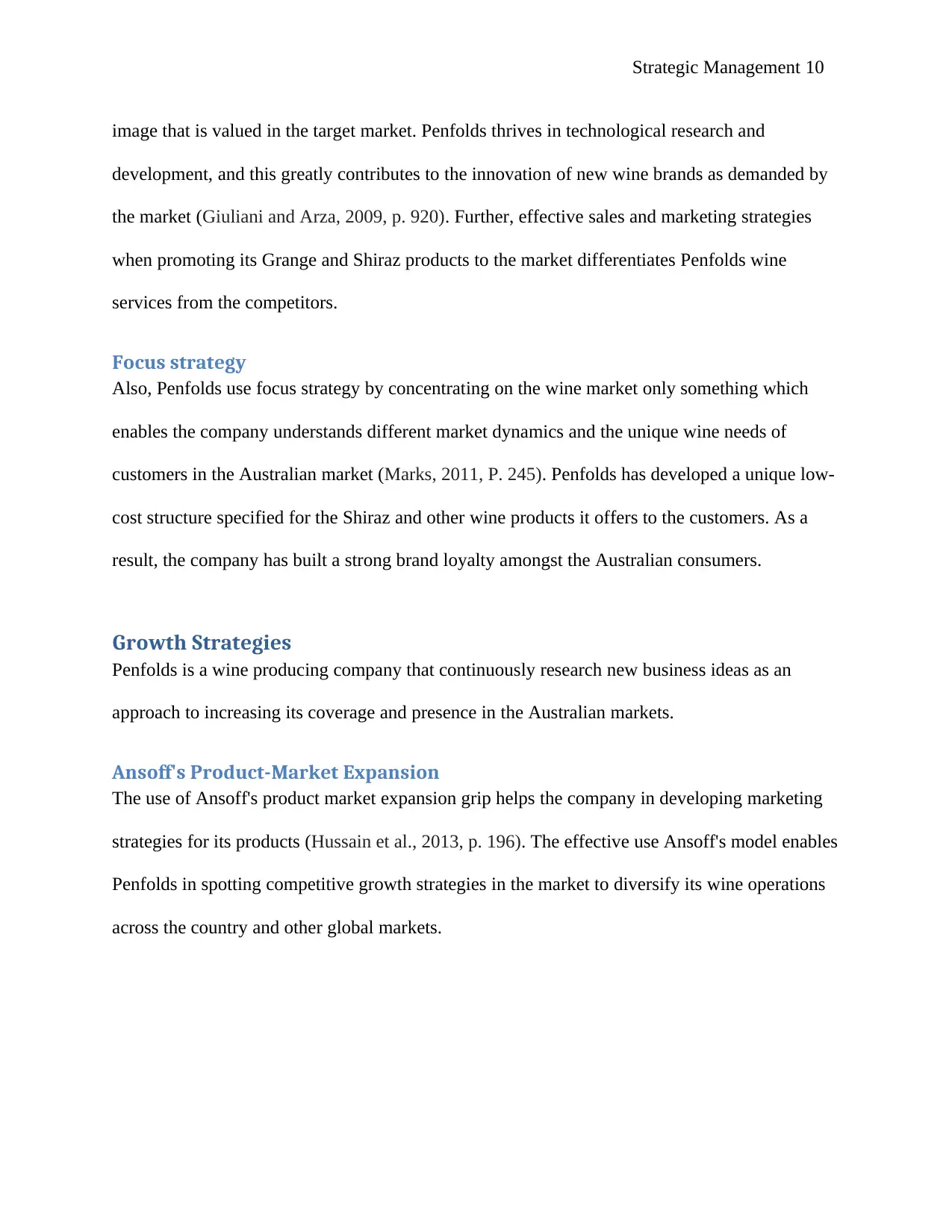
Strategic Management 10
image that is valued in the target market. Penfolds thrives in technological research and
development, and this greatly contributes to the innovation of new wine brands as demanded by
the market (Giuliani and Arza, 2009, p. 920). Further, effective sales and marketing strategies
when promoting its Grange and Shiraz products to the market differentiates Penfolds wine
services from the competitors.
Focus strategy
Also, Penfolds use focus strategy by concentrating on the wine market only something which
enables the company understands different market dynamics and the unique wine needs of
customers in the Australian market (Marks, 2011, P. 245). Penfolds has developed a unique low-
cost structure specified for the Shiraz and other wine products it offers to the customers. As a
result, the company has built a strong brand loyalty amongst the Australian consumers.
Growth Strategies
Penfolds is a wine producing company that continuously research new business ideas as an
approach to increasing its coverage and presence in the Australian markets.
Ansoff's Product-Market Expansion
The use of Ansoff's product market expansion grip helps the company in developing marketing
strategies for its products (Hussain et al., 2013, p. 196). The effective use Ansoff's model enables
Penfolds in spotting competitive growth strategies in the market to diversify its wine operations
across the country and other global markets.
image that is valued in the target market. Penfolds thrives in technological research and
development, and this greatly contributes to the innovation of new wine brands as demanded by
the market (Giuliani and Arza, 2009, p. 920). Further, effective sales and marketing strategies
when promoting its Grange and Shiraz products to the market differentiates Penfolds wine
services from the competitors.
Focus strategy
Also, Penfolds use focus strategy by concentrating on the wine market only something which
enables the company understands different market dynamics and the unique wine needs of
customers in the Australian market (Marks, 2011, P. 245). Penfolds has developed a unique low-
cost structure specified for the Shiraz and other wine products it offers to the customers. As a
result, the company has built a strong brand loyalty amongst the Australian consumers.
Growth Strategies
Penfolds is a wine producing company that continuously research new business ideas as an
approach to increasing its coverage and presence in the Australian markets.
Ansoff's Product-Market Expansion
The use of Ansoff's product market expansion grip helps the company in developing marketing
strategies for its products (Hussain et al., 2013, p. 196). The effective use Ansoff's model enables
Penfolds in spotting competitive growth strategies in the market to diversify its wine operations
across the country and other global markets.
Paraphrase This Document
Need a fresh take? Get an instant paraphrase of this document with our AI Paraphraser

Strategic Management 11
Market penetration strategy
Penfolds Grange Shiraz aims at increasing its wine products sales and profitability. The effort of
the company seeks to provide Grange and Shiraz red wines products to all target markets, and
this forms its market penetration strategy ((Hussain et al., 2013, p. 198). However, close rivals
such as Southcorp and BRL Hardy have employed better foreign market penetration strategies in
the existing market. Penfolds needs to, therefore, concentrate on both the existing and new
markets in order to remain competitive as it enters new markets.
Market development strategy
The development of new markets for a company's existing and new products is known as a
market development strategy. Penfolds has established excellent strategies of spotting new
markets for its Grange and Shiraz red wines products hence increasing its domestic and global
presence in the wine production industry (Hussain et al., 2013, p. 200). Development of more
global markets for Penfolds wine products has made the company among the world’s most
reliable, valuable and competitive producers of red wine.
Product development strategy
Market penetration strategy
Penfolds Grange Shiraz aims at increasing its wine products sales and profitability. The effort of
the company seeks to provide Grange and Shiraz red wines products to all target markets, and
this forms its market penetration strategy ((Hussain et al., 2013, p. 198). However, close rivals
such as Southcorp and BRL Hardy have employed better foreign market penetration strategies in
the existing market. Penfolds needs to, therefore, concentrate on both the existing and new
markets in order to remain competitive as it enters new markets.
Market development strategy
The development of new markets for a company's existing and new products is known as a
market development strategy. Penfolds has established excellent strategies of spotting new
markets for its Grange and Shiraz red wines products hence increasing its domestic and global
presence in the wine production industry (Hussain et al., 2013, p. 200). Development of more
global markets for Penfolds wine products has made the company among the world’s most
reliable, valuable and competitive producers of red wine.
Product development strategy

Strategic Management 12
The current wine products produced by Penfolds are Shiraz and Grange brands. Due to
investment in technology and advanced recruitment of talented staff- Penfolds has been
modifying and developing these products by adding more attractive and unique features that
attract more customers globally (Hussain et al., 2013, p. 202). Also, the company uses social
media marketing, Google Ads, and other digital advertising techniques in promoting its wine
products in the market.
Diversification strategy
Diversification strategy entails the establishment of new product offerings in the new markets
identified by a company. The company has been determined in the creation and innovation of
new red wines products as demanded in the market, and this diversifies its product offerings.
Also, Penfolds has diversified its wine operations by partnering with companies from other
industries such as the insurance, transport, health, and banking and finance (Boriraj, 2008, p. 10).
As a result, the company has established promising business outside the scope of its current and
main wine production business segmentation.
Recommendations and Conclusions
Australian wine industry is among the leading producers of wine in the world. Australia aims at
becoming the leading wine producer in the world by 2025. However, with the current
management and operations of Penfolds in its wine business, this dream may go unrealized and
unmet (Barney and Hesterly, 2010, p. 2). Therefore, Penfold in partnership with the Australian
government should adjust their wine production operations and business in the market in the
following ways:
The current wine products produced by Penfolds are Shiraz and Grange brands. Due to
investment in technology and advanced recruitment of talented staff- Penfolds has been
modifying and developing these products by adding more attractive and unique features that
attract more customers globally (Hussain et al., 2013, p. 202). Also, the company uses social
media marketing, Google Ads, and other digital advertising techniques in promoting its wine
products in the market.
Diversification strategy
Diversification strategy entails the establishment of new product offerings in the new markets
identified by a company. The company has been determined in the creation and innovation of
new red wines products as demanded in the market, and this diversifies its product offerings.
Also, Penfolds has diversified its wine operations by partnering with companies from other
industries such as the insurance, transport, health, and banking and finance (Boriraj, 2008, p. 10).
As a result, the company has established promising business outside the scope of its current and
main wine production business segmentation.
Recommendations and Conclusions
Australian wine industry is among the leading producers of wine in the world. Australia aims at
becoming the leading wine producer in the world by 2025. However, with the current
management and operations of Penfolds in its wine business, this dream may go unrealized and
unmet (Barney and Hesterly, 2010, p. 2). Therefore, Penfold in partnership with the Australian
government should adjust their wine production operations and business in the market in the
following ways:
⊘ This is a preview!⊘
Do you want full access?
Subscribe today to unlock all pages.

Trusted by 1+ million students worldwide
1 out of 16
Related Documents
Your All-in-One AI-Powered Toolkit for Academic Success.
+13062052269
info@desklib.com
Available 24*7 on WhatsApp / Email
![[object Object]](/_next/static/media/star-bottom.7253800d.svg)
Unlock your academic potential
Copyright © 2020–2025 A2Z Services. All Rights Reserved. Developed and managed by ZUCOL.





